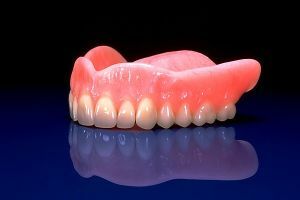 The material used to make dentures must have many special properties that most of us do not even suspect. It is not only the naturalness of the teeth color and high strength. It should be stable in size, not smell and taste, be repairable, do not emit harmful substances, have good thermal conductivity and resistance to bacteria. And, of course, its value should not be too high.
The material used to make dentures must have many special properties that most of us do not even suspect. It is not only the naturalness of the teeth color and high strength. It should be stable in size, not smell and taste, be repairable, do not emit harmful substances, have good thermal conductivity and resistance to bacteria. And, of course, its value should not be too high.
There is not much to find materials that meet all these requirements. One of them is acrylic plastic based on polymethylmethacrylate. Due to their special properties, acrylic dentures have displaced constructions made of rubber and other precursor materials and are currently the most popular in the field of dental prosthetics.
Contents of
- Designs and types of acrylic denture
- Advantages and disadvantages of using acrylic
- Comparative characteristics of
- Indications and contraindications to installation
- Manufacturing technology
- Maintenance of prosthesis
- Types of operational defects and repair
- Adaptation period
- Service life
- View
- Manufacturing costand installations
Constructions and types of prosthetic acrylic
Acrylic removable prosthesis is a plastic base of roses(under the color of the gum) color with artificial teeth embedded in it.
Its design depends on whether there are teeth in the patient's mouth or are completely absent. Depending on this, removable dentures from acrylic plastic can be:
- complete;
- by cover;
- partial.
Each design is installed in a specific case:
- The complete prosthesis is manufactured in the absence of all teeth. It relies only on the gums and the sky( if it's the upper jaw).Fixation of the
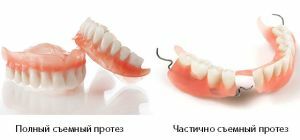 prosthesis on the gum occurs due to the vacuum - a vacuum is created between it and the mucous surface, which keeps the structure in place.
prosthesis on the gum occurs due to the vacuum - a vacuum is created between it and the mucous surface, which keeps the structure in place. - Cover prostheses are also used in the absence of teeth in the patient. But they are not attached to the gum, but to implants - pins, embedded in the jaw bone specifically for fixing the prosthesis.
- Partial dentures replace the missing set of teeth. They rely on the gum and are additionally attached to adjacent teeth by special mechanisms in the form of arches, clasps or locks-attachments.
Prostheses are made from acrylic by injection molding. In the prepared form a liquid plastic is supplied through a special channel, which, solidifying, accurately copies the configuration of the mold.
Advantages and disadvantages of using acrylic
First about the obvious advantages, thanks to which acrylic dentures have become so popular that they can be called "folk":
- High aesthetics of .Acrylic plastic can be given any color shade. Usually, it is matched to the tone of the gums and your own teeth, but if necessary, you can do it to others. And most importantly, the color is stable and persists throughout the life of the product.
- Easy removal and installation of .
- Uniform pressure distribution of the gum prosthesis on the .
- Light weight .Acrylic construction does not create a sense of gravity, which contributes to rapid adaptation to it.
- Low price, making available acrylic dentures to almost all categories of citizens. On the "price-quality" parameter, they unequivocally occupy the first place.
- Technologicality of .In comparison with other types of prosthetics, the manufacture of a prosthesis made of acrylic takes relatively little time.
- Good maintainability of .If there is a loss of the prosthetic tooth, or there are chips and cracks on the basis, this is easily corrected by repair.
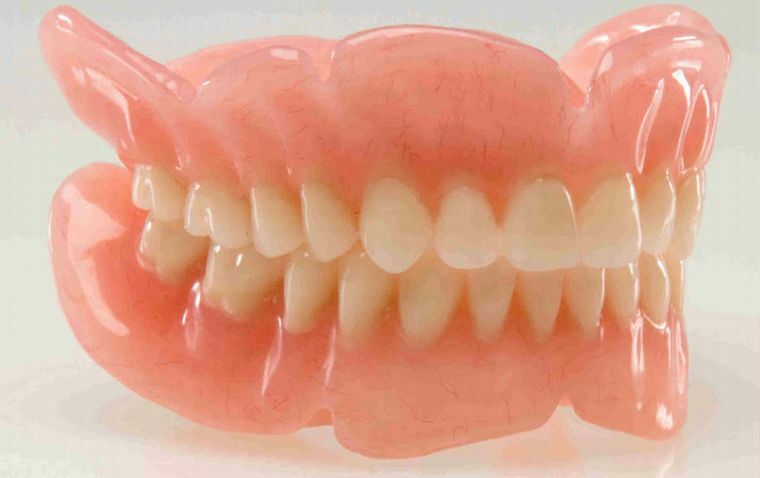
The cons of acrylic prostheses are largely determined by the quality of their manufacture and the way they are used. The most significant ones are as follows:
- Adoption of is quite long. It may take up to 2 months to stop experiencing discomfort in the oral cavity.
- Sometimes there is a trauma to the gums or other mucous tissues of the .Usually this happens when the prosthesis is not properly fitted.
- For long-term use, the prosthesis can damage the enamel of the native teeth of the and launch a carious process in them.
- The possibility of allergy .The acrylic plastic used contains some allergenic substances. They are not so dangerous as to cause any significant harm to the health of the consumer, but are sufficient for allergic manifestations.
- The hardness of acrylic plastic sometimes leads to cracks in the prosthesis.
- Insufficiently rigid fixation on the gums of the .Most often this concerns full prostheses, which are held by the effect of the suction cup. This defect is eliminated by using a special glue, with which the design is glued to the gum.
- The porous structure of plastic promotes the accumulation of microorganisms on its surface that can cause periodontitis, stomatitis and gingivitis.
- There are cases of of an individual intolerance to dentures made of acrylic, which can be manifested by nausea and vomiting. Sometimes this leads even to the need to abandon the prosthesis.
Comparative characteristics of
Acrylic prosthesis is superior to its predecessors( rubber and other products), but in some respects inferior to structures from more modern materials, in particular, from nylon. Below is a table where you can evaluate which prosthesis is best for one or the other parameters-non-silicone or acrylic:

Indications and contraindications for the installation of
The main indication for the installation of removable acrylic teeth is the need to restore the masticatory function that is lost with complete or partial loss of teeth.
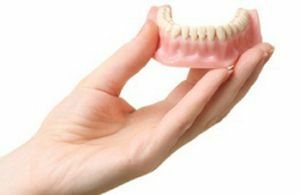 Most often this is relevant for the elderly. But acrylic dentures can be required and young people - as a temporary solution, for example, after tooth extraction before prosthetics.
Most often this is relevant for the elderly. But acrylic dentures can be required and young people - as a temporary solution, for example, after tooth extraction before prosthetics.
Sometimes need acrylic prosthetics and children - when correcting an incorrect bite due to the loss or destruction of baby teeth.
Contraindication is usually an allergic reaction to acrylic components or degradation of the jawbone. In some cases, a contraindication becomes observed in some patients increased gag reflex to the prosthesis.
Symptoms that can talk about allergies to acrylic:
- burning and / or dry mouth;
- an unfamiliar taste of food;
- strong salivation;
- inflammation on the gums, tongue, mucous membranes.
Manufacturing technology
The time of manufacturing the prosthetic construction from acrylic depends not only on the natural duration of technological operations, but also on the operating mode of the dental laboratory, its equipment, etc. It is usually 3-10 days.
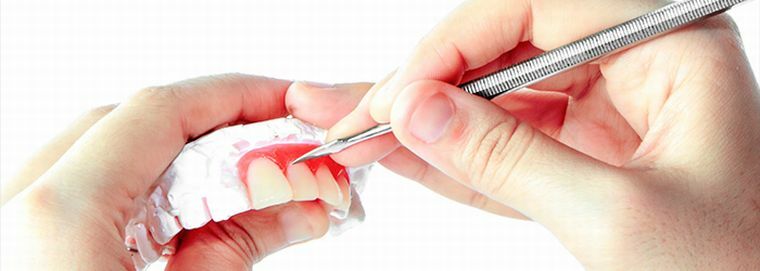
The process of manufacturing the prosthesis consists of the following stages:
- preparatory phase - the impression is taken from the upper and lower jaws, if necessary, crowns are placed on the supporting teeth.
- on the obtained impressions, a gypsum model is made, after which bite rolls are then made;
- tooth extraction using bite ridges( the patient eats them);
- wax base production;
- baseline sample;
- casting of the prosthesis, its grinding and polishing;
- fitting and correction of the prosthetic construction.
Care of the prosthesis
Acrylic products need the same care as prosthetic structures made from other materials, namely: 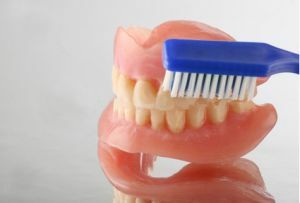
- cleaning of the prosthesis after each meal, rinsing the oral cavity;
- periodic disinfection with compounds that are sold at the pharmacy;
- professional cleaning in the dental department - 1-2 times a year;
- rejection of too hard and sticky food - crackers, nuts, iris, chewing gum t. N;
- occasional visit to the dentist to inspect the prosthesis for defects.
Types of operational defects and repair
Most of the damages of prosthetic structures made of acrylic can be corrected without wasting new ones. Repair may be necessary in the following cases:
- when removing the supporting tooth instead of it, an additional artificial one is added to the existing basis;
- loss or incision of an artificial tooth - is replaced by a new one;
- failure of the locking device, by means of which the prosthesis is attached to the supporting teeth;
- violation of adherence of the prosthesis to the gums - correction of the base will be required;
- fracture of the basis - depending on the defect, the prosthesis changes or is repaired.
Adaptation period
When planning the installation of acrylic prostheses, the patient should be aware that he will not fully experience the comfort of acquiring new teeth, but with some delay after installation. Hard material at first will put pressure on soft tissues, causing pain or, at least, discomfort. There can be a change in taste and temperature sensations.
 Usually adaptation lasts 1-2 months. This time is required for fitting the prosthesis and getting used to it. As a rule, there is a need for several visits to the doctor to adjust the prosthesis.
Usually adaptation lasts 1-2 months. This time is required for fitting the prosthesis and getting used to it. As a rule, there is a need for several visits to the doctor to adjust the prosthesis.
To reduce the adaptation time, it is recommended to wear the prosthesis as much as possible - even despite the discomfort. Initially, 2 hours of continuous wearing with a 10-15-minute breathing space, then more. At first, it is advisable not to remove the prosthesis for the night.
In the future, as it gets used, the prosthesis is removed in the evening and stored until the morning in a disinfectant solution. To quickly restore the diction, you need to talk more.
Service life
Several factors influence the service life of products, the main ones of which are proper operation and proper maintenance. Influence on the durability of the prosthetic structure and atrophic changes in the jaw bones.
With proper care and absence of bone degradation, the life of an acrylic denture is 5 years or more. Under adverse conditions, it can be reduced to 2.5 years.
Viewpoint
Reviews of patients from dental clinics who have manufactured and installed acrylic dentures.
I lost four lower front teeth. Not immediately, of course, gradually. I had to go to the dentist who made an acrylic prosthesis.
When everything was ready, he said that he would have to come several times to adjust, but for now it is necessary to vilify so that the problem areas are determined. Indeed, in some places, when chewing, there was pain, but I did not go to the doctor anymore, with the help of a nail file and a thin skin I corrected all the problem areas myself.
It was almost unnecessary to get used, maybe only a few days. I wear a prosthesis for more than 4 years, I have no problems.
In general, I do not even understand why it is believed that the life of the prosthesis of acrylic is 4-5 years. On my for 4 years, there were no defects. I see no reason why he could not work for another couple of years.
Andrey, 60 years old
I somehow had a prejudice against removable dentures. I wanted to make permanent bridges, but the doctor advised nevertheless a removable acrylic prosthesis. I believed, I agreed and I was not mistaken.
The prosthesis rose as if it were poured, even the speech did not noticeably notice any damage. A couple of times I went for revision, after which the discomfort, which was already small, was completely gone. I wear acrylic teeth for 2 years already, I do not find any defects on it.
Thanks to the doctor for his attentive attitude and good advice, and for the work too. As I understood, making a denture is a very delicate matter, requiring real skill.
Elena, 55 years
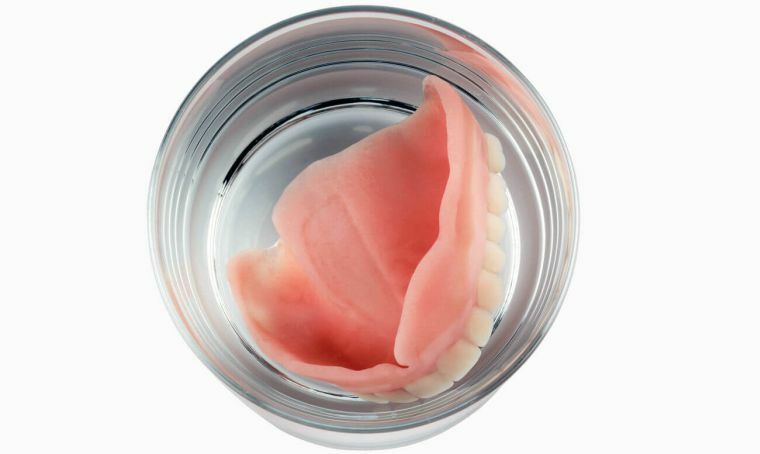
Cost of manufacturing and installation
The comparatively low price of acrylic dentures allows them to have people with any income. For example, an acrylic prosthesis on the entire jaw( full) can cost the patient from 10,000 rubles, while the initial price of nylon is at least 18,000 rubles.
